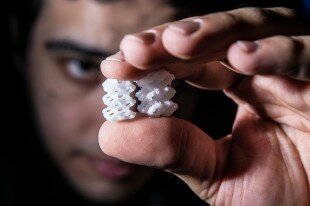Rice University bioengineering researchers have modified a commercial-grade CO2 laser cutter to create OpenSLS, an open-source, selective laser sintering platform that can print intricate 3-D objects from powdered plastics and biomaterials. The system costs at least 40 times less than its commercial counterparts and allows researchers to work with their own specialized powdered materials.
Researchers in the Miller Lab at Rice University’s Department of Bioengineering used a commercial-grade CO2 laser cutter to create OpenSLS, an open-source, selective laser sintering platform that can print intricate 3-D objects from powdered plastics and biomaterials.
The design specs and performance of Rice’s OpenSLS platform, an open-source device similar to commercially available selective laser sintering (SLS) platforms, are described in an open-access paper published in PLOS ONE. OpenSLS, which was built using low-cost, open-source microcontrollers, cost less than $10,000 to build; commercial SLS platforms typically start around $400,000 and can cost up to $1 million.
“SLS technology has been around for more than 20 years, and it’s one of the only technologies for 3-D printing that has the ability to form objects with dramatic overhangs and bifurcations,” said study co-author Jordan Miller, an assistant professor of bioengineering at Rice who specializes in using 3-D printing for tissue engineering and regenerative medicine. “SLS technology is perfect for creating some of the complex shapes we use in our work, like the vascular networks of the liver and other organs.”
He said commercial SLS machines generally don’t allow users to fabricate objects with their own powdered materials, which is something that’s particularly important for researchers who want to experiment with biomaterials for regenerative medicine and other biomedical applications.
“Designing our own laser-sintering machine means there’s no company-mandated limit to the types of biomaterials we can experiment with for regenerative medicine research,” said study co-author Ian Kinstlinger, a graduate student in Miller’s group who designed several of the hardware and software modifications for OpenSLS. The team showed that the machine could print a series of intricate objects from both nylon powder — a commonly used material for high-resolution 3-D sintering — and from polycaprolactone, or PCL, a nontoxic polymer that’s commonly used to make templates for studies on engineered bone.
“In terms of price, OpenSLS brings this technology within the reach of most labs, and our goal from the outset has been to do this in a way that makes it easy for other people to reproduce our work and help the field standardize on equipment and best practices,” Kinstlinger said. “We’ve open-sourced all the hardware designs and software modifications and shared them via Github.”
OpenSLS works differently than most traditional extrusion-based 3-D printers, which create objects by squeezing melted plastic through a needle as they trace out two-dimensional patterns. Three-dimensional objects are then built up from successive 2-D layers. In contrast, the SLS laser shines down onto a flat bed of plastic powder. Wherever the laser touches powder, it melts or sinters the powder at the laser’s focal point to form a small volume of solid material. By tracing the laser in two dimensions, the printer can fabricate a single layer of the final part.
“The process is a bit like finishing a creme brulee, when a chef sprinkles out a layer of powdered sugar and then heats the surface with a torch to melt powder grains together and form a solid layer,” Miller said. “Here, we have powdered biomaterials, and our heat source is a focused laser beam.”
In SLS, after each layer is finished, a new layer of powder is laid down and the laser reactivates to trace the next layer.
Source: Rice University Press Release



